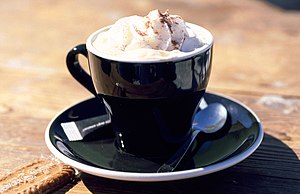Cappuccino
Cappuccino is an Italian beverage, prepared with espresso and milk. A cappuccino is generally defined as 1/3 espresso, 1/3 steamed milk and 1/3 frothed milk. Another definition would call for 1/3 espresso and 2/3 microfoam. A cappuccino differs from a cafe latte, which is mostly milk and little foam. (A "dry cappuccino" has less milk.) The "iced cappuccino" (or Freddo cappuccino) beverage is somewhat of a misnomer since there is no way to duplicate the foam on top of the hot beverage, but the term is nevertheless widely spread in some Mediterranean countries where ice is added before the foam. Espresso and cold milk on ice is called an iced cafe latte, while an espresso macchiato is a shot of espresso "stained" with a dollop of milk foam.
In Italy cappuccino is generally consumed early in the day as part of a light breakfast, although it is not uncommon to see Italians drinking it (without food) throughout the day; Italians do not generally drink it with meals other than breakfast. In other countries it is consumed throughout the day or after dinner.
Besides a quality shot of espresso, the most important element in preparing a cappuccino is the texture and temperature of the milk. When a barista steams the milk for a cappuccino, he or she creates microfoam by introducing very tiny bubbles of air into the milk, giving the milk a velvety texture and sweetness. In some places, skilled baristas create latte art when pouring properly steamed milk into the espresso, making designs such as apples, hearts, leaves, rosettes, and corporate logos.
A cappuccino is ideally prepared in a ceramic coffee cup, which has far better heat retention characteristics than glass or paper.
Cappuccino was a taste largely confined to Europe and the more cosmopolitan regions of North America (such as the East and West coasts of the US, and large Mexican cities, where it has been popular for many decades), until the mid-1990s when cappuccino was made much more widely available to North Americans, as part of the new upscale coffee bar chains with a consciously created "European" ambience (such as Starbucks). By the first years of the 21st century a modified version of cappuccino was being served by the McDonald's fast-food chain. At America's most popular coffee chain, Starbucks, a cappucino has only about 1/8 espresso (as opposed to the traditional 1/3) unless extra shots are ordered.
The widespread acceptance in the U.S. of what was once regarded as a taste of coastal urbanites and older Italian-Americans led to many establishments, such as convenience stores offering what they represent as cappuccino to their patrons. However, that product is usually an ersatz cappuccino - sometimes called "cappucheapo" - produced by machines similar to those that mix cocoa drinks where all the buyer need do is touch a button and position the cup properly. The drink that comes out is usually produced either from a preproduced mix or double-brewed coffee and bears little relation to the real thing.
Similar products result from home use of store-bought mixes usually advertised, more accurately, as producing "frothed coffee."
Origins
The origin of the name is in the brown hooded silken golden embroidered robes worn by the Capuchin order of Franciscan friars. In France at the beginning of the 18th century a new fashion arose in Paris (though not at Versailles) for carved wall-panelling boiseries that were left in their natural color (almost invariably oak) rather than being painted and gilded as in the previous century. The new mode, which coincided with the height of the controversy over Jansenisme that was dividing the tout Paris in stylish religious pamphleteering, was wittily termed à la capucine in reference to the brown color of the robes worn by Franciscan friars. This color-coded etymology is followed by the Oxford English Dictionary and the American Heritage Dictionary. The order of Capuchins was, in turn, named for the capucize (cappuccio), or long pointed cowl, worn by the friars.
Devotees of the Blessed Marco d'Aviano offer a (likely apocryphal) twist on the origin of the term. According to this legend, Marco d'Aviano, the Capuchin friar and confidant of Leopold I, Holy Roman Emperor, added milk and honey to sweeten the bitter coffee beans left by fleeing Ottoman Turkish army after the Battle of Vienna (1683). A similar legend, with slightly more credibility is told about the origin of the first Viennese cafe by Franciszek Jerzy Kulczycki.

